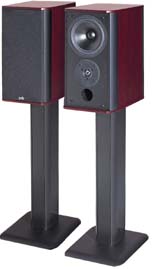| Columns Retired Columns & Blogs |
PSB New Stratus Mini
While large, floorstanding speakers appear to offer the most material for the buck, I feel that small stand-mounted speakers both offer the best value in sound quality, as well as standing the best chance of sounding good in moderate-sized listening rooms. In recent months Stereophile has reviewed a varied group of such speakers. In order of descending price, these include the Acoustic Energy AE2 Signature ($5495/pair, November '95); Dzurko Acoustics Jaguar ($4500/pair, reviewed elsewhere in this issue); Totem Mani-2 ($3995/pair, February '96); Platinum Audio Solo ($2498/pair, November '95); Coincident Speaker Technology Troubador ($1495/pair, January and February '96); Joseph Audio RM7si ($1299-$1499/pair, February '96); Acarian Alón Petite ($995-$1195/pair, January '96); Phase Technology PC80 II ($699/pair, December '95); and Spectrum 108cd ($399/pair, December '95).
 The variation in sound quality in this group was as wide as the price range, with the Acoustic Energy AE2 and Totem Mani-2 achieving the highest absolute quality. However, the Platinum Solo, Alón Petite, and Phase Technology PC80 perhaps offer the best values for money, albeit at differing performance levels.
The variation in sound quality in this group was as wide as the price range, with the Acoustic Energy AE2 and Totem Mani-2 achieving the highest absolute quality. However, the Platinum Solo, Alón Petite, and Phase Technology PC80 perhaps offer the best values for money, albeit at differing performance levels.
This month I review three more small stand-mounted speakers. One is from the UK, B&W's Compact Domestic Monitor 1; one from France, JMlab's Micron Carat; and one from Canada, the latest version of PSB's Stratus Mini. All are reflex-loaded two-ways. All could be regarded as high-performance minimonitors. All are very competitively priced.
PSB New Stratus Mini: $950-$1050/pair
The original Stratus Mini was a firm recommendation at the $1000/pair level. Indeed, I ended my June 1993 review (Vol.16 No.6) with the observation that "the PSB Stratus Mini has a neutral tonal balance, a low level of coloration, and both superb soundstaging and superb representation of recorded ambience...with a convincingly accurate presentation of instrumental tone colors." Obviously, the use designer Paul Barton makes of the Canadian government's NRC anechoic chamber in Ottawa pays off in a big way.
Whereas the original Mini had a somewhat clumsy-looking, wide-aspect-ratio cabinet, the New Mini is deeper than it is wide, and looks extremely elegant, particularly in its optional gloss-black finish. The cabinet is made from ¾" high-density fiberboard, with tongue-and-groove construction and a horizontal H or figure-8 brace. Black-anodized aluminum extrusions form the enclosure's four vertical corners, these also used to form the pillars of the matching 25" stands. (These good-value stands are heavily constructed from MDF and can be filled with leadshot and/or sand.) The black grillecloth is stretched over a particleboard frame that fits between ½" lips formed by the cabinet's top and bottom panels extending in front of the baffle. The speaker is intended to be used with the grilles in place.
The drive-units appear to be the same as the original's: a ¾" aluminum-dome tweeter coupled to a polypropylene-coned woofer, both sourced from Vifa in Denmark. Unusually, the woofer is mounted above the tweeter; the drive-unit phasing and spacing and the crossover filters have been chosen to make the speaker sound most neutrally balanced on the woofer axis. Below the tweeter on the front baffle is a 2"-diameter port some 6" deep.
Electrical connection is via two pairs of 4mm binding posts, these attached to a plastic terminal plate recessed on the cabinet rear. The crossover is mounted on two printed circuit boards attached to the inside of this panel. The specified filter slopes are 24dB/octave Linkwitz-Riley; the electrical filters appear to be a second-order high-pass to the tweeter and a fourth-order low-pass to the woofer, implemented with two air-cored and one transformer-cored inductors and non-polar electrolytic capacitors. The woofer and tweeter terminals were mislabeled on the review samples—fortunately, an easy error to catch.
- Log in or register to post comments




































